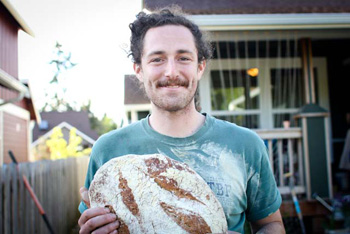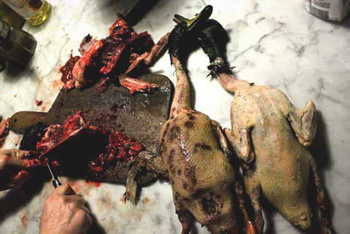|
|
|
 By Eliot Fearey  Andrew Plotsky of Farmrun Andrew Plotsky is going to convince you that a pig’s caul is a beautiful matrix. Then, he is going to inspire you to cook something that you haven’t ever heard of before. But, most importantly, he is going to get you excited about a new wave of environmentally responsible and socially conscientious agriculturalists. Inspired by farmers he met while driving across the country, Andrew started Farmrun, a multimedia production studio that documents the work of young innovators who are invested in the food movement. Farmrun combines his critical study of the environment, talents in graphic design, and passion for cooking. Andrew’s work takes the form of documentary film, photography, and written narrative. One might say he’s a bit of a Renaissance man. Discussions about the food movement are all too often tinged with a note of hysteria. Farmrun is a refreshing divergence from this trend. Andrew’s work, be it his photographic portrait series of bread products or his narrative recounting the history of butchery, is imbued with lyricism and wit. Andrew’s focus is unceasingly the amelioration of our food economy and his work makes me...want to eat.
Andrew Plotsky: If it is not documented, then it is not communicated. People are starting to pay more attention to what they eat and, all of a sudden, there are a lot more ranchers, farmers, and beekeepers. These trades are very demanding and very time consuming. But, there is significant value to this work and that value needs to be communicated. For the goodness of the food movement, I want to clearly and beautifully communicate the importance of responsible agricultural work to as broad of an audience as possible.
 Duck Processing (credit - Andrew Plotsky) Andrew Plotsky: There have been a number that were particularly fantastic. The unifying thread among those that are fantastic is that their proprietors are especially enthusiastic and focused. In Portland, Maine, there are two guys, Eli Cayer and Dave Homa, who have started the Urban Farm Fermentory. They rented a formerly industrial 500 square foot warehouse space and are using it for their commercial fermenting business. Also, in the back, they planted an urban vermaculture space, from which they are running educational programming.
Andrew Plotsky: I think it is sort of omnipresent because there is a sense of urgency with this movement. The agricultural landscape is heading in a good direction. But, proportionally, the amount of good food that is being produced and consumed is miniscule. People who are knowledgeable are invested in implementing change and, generally, eager to impart their knowledge to those who are interested.
Andrew Plotsky: The intention of the video series is to instruct on particular butchery related processes in a way that is beautiful and reflects the values of responsible agriculture. The first film in the series, Side Butchery, features Brandon’s knowledge as a butcher and will teach you how to quarter a pig. Then, there is an historical anecdote that illustrates, to the best of my abilities, the history of butchery. Also, there are recipes that I curated and have cooked with Brandon.
Andrew Plotsky: We decided to make the videos free and available to everyone because Brandon’s skill set is in very high demand and needs to be communicated beautifully. It was also a decision that, I feel, is in line with the inclinations and values of agriculturalists. Historically, the knowledge of a butcher was, by virtue of tradition, a communal knowledge. In the last century, that knowledge has been robbed from us. But, personally, I just want to give people beautiful things that are useable to them. That is really what it comes down to.
Andrew Plotsky: I believe there is significant beauty in pig guts. By that I mean, there is significant beauty in simplicity, existence, and the mundane. It is difficult for me to vocalize, but when it comes to creating a film, I am trying to satisfy my desire to find beauty in what is often overlooked. I love to accentuate what is often ignored.  Honey Cure (credit - Andrew Plotsky) THIRSTY: Don’t you think that slaughter and innards are overlooked because they are considered grotesque? Andrew Plotsky: I would argue that they are considered grotesque because they are estranged.
Andrew Plotsky: The expense of the food comes from the fact that the farmers are trying to pay themselves an equitable wage. They are trying to create an income by producing food, by playing their part. The system that we have in place makes it very difficult to produce good food and that, in turn, makes producing good food very expensive. Farmers want everybody to have their food, but they also want to be able to afford their living expenses.
Andrew Plotsky: Feet. Pig’s feet are the best. They’re awesome!
Andrew Plotsky: Well, they are great for stock because they have a lot of tendon and ligament. Connective tissue translates to gelatin, which is very rich in flavor. You could also make aspic out of the trotter, that’s cool. But, my favorite way to eat a pig’s foot is to boil it, cut it in half, and then fry it in fat. It’s unbelievable. The feet aren’t fleshy. There is no meat on them. But, the trotter turns into a semi-gelatinous matrix with skin and, when cooked properly, it will crisp. A pig’s foot is what a chicken wing wants to be.
All opinions expressed by Eliot Fearey are solely her own and do not reflect the opinions of Stay Thirsty Media, Inc.
Privacy Policy | Terms of Use | Terms of Sale | Contact | Site Map |
|
|











